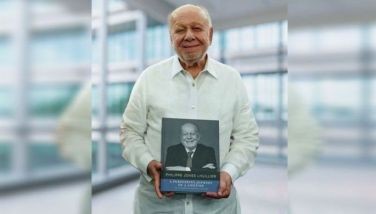Dancing in the new year

Shifu Arnold Buenviaje of the Philippine Mingsheng Wenyang Sports Association sits among the various colorful dragon and lion heads. Ida Del Mundo
Manila, Philippines — Lively dragon and lion dances accompanied by energetic drumming will soon be performed all over the country and the world to usher in Chinese New Year on Feb. 16. Believed to bring good luck, the mythical dragon represents the emperor, says shifu Arnold Buenviaje of the Philippine Mingsheng Wenyang Sports Association, one of the biggest dragon and lion dance groups in the country.
The dragon is made up of many dancers moving in synchrony, sometimes even reaching up to 15 segments, all while following a pearl that symbolizes its life and wisdom.
The lion dance, on the other hand, is performed by only two dancers and has an interesting origin story as well, says Buenviaje.
Lions are not native to China, he points out. However, in ancient China, when there was a mysterious animal destroying the crops of the farmers, they made a model of it and the beast turned out looking like a lion.
The farmers then drove it away by banging pots and pans. This developed into the lion dance we know today and has branched out into the northern and southern styles – acrobatic for the former and martial arts-based for the latter.
Nowadays, aside from being performed during the New Year or at important events, modern dragon and lion dancing has become a sport, says Buenviaje.
There is a luminous dragon competition, which started in Singapore, wherein performers dance in the dark, lit only by black lights, creating the effect of a floating dragon.
For the lion, there are thrilling high post competitions, wherein pairs jump from post to post, which are about eight feet off the ground, with 21 posts creating a 13 meter-long path of peril.
The Philippine Mingsheng Wenyang Sports Association recently joined an international dragon and lion dance competition hosted in Hong Kong, reaching the finals against other top groups from Singapore, Malaysia, China and Hong Kong. “These are groups that really excel in their countries,” says Buenviaje. The Philippine team put up a good showing, but suffered a high post fall in the finals.
The Philippine Mingsheng Wenyang Sports Association was established in 2006. Whenthey started, they had to practice in the parking lot, with no place to store their props. Much has improved since then, says Buenviaje, and with improvements in their facilities came several achievements and recognitions for the group, including a championship title for women’s lion dance in a competition held in Macau in 2015.
Internationally-trained in Chinese martial arts and a former member of the Philippine national wushu team, Buenviaje originally opened his gym as a martial arts school. After receiving training in dragon and lion dancing and drumming from the Singapore Wenyang Sports Association, he decided to start offering dragon and lion dance to his students. He adds, with the dragon and lion dance there are several opportunities to travel and compete around the world. In fact, the team travels three to four times a year.
Buenviaje emphasizes that the group uses their earnings from performances during the New Year and other occasions to fund their training and travels. “Everything is for the athletes,” he says.
The team, composed of both students and young professionals, trains the whole year round, while balancing work or school. Those who have been with the group for five years or more “can do it in their sleep,” says Buenviaje. For competitions, they practice their routine for four to five months.
Looking towards the New Year, Buenviaje hopes that Filipinos will take the dragon and lion dance game one step higher – and that they will be supported as athletes so they can really concentrate on even better training.
For the group, he dreams of a permanent place; a bigger gym where they can practice and keep all their props and costumes safe. It is difficult, but the dragon and lion dancers are there for the love of the art and sport, says Buenviaje with pride.
There are two kinds of winners,” says Buenviaje on a champion dragon dance team. “One that makes the routine smooth and one that makes the routine really fast. You have to jump high, flow with the dragon, and be synchronized with the music.”
The luminous dragon is even more difficult because you can’t see what is in front of you. “All you can see is the body of the dragon,” says Buenviaje.
To be successful in the darkness, Buenviaje says, “It’s a group thing. You have to work as a group. Even if your head is really good, but the body is not good, you’re going to fail.”
Shifu adds, you must have trust in your team; practice hard until movements become second nature; work together – valuable advice that can be applied not only to dragon dancing, but also to life as we look forward to the Year of the Earth Dog.
- Latest
- Trending



















